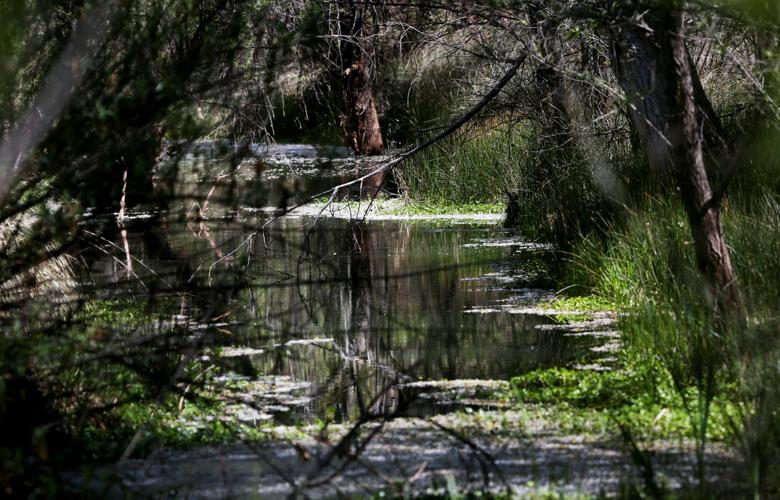Four environmental groups sued the U.S. Forest Service Monday, saying the proposed Rosemont Mine will violate laws and regulations protecting the water flowing in neighboring streams.
The lawsuit challenges the Forest Service’s repeated statements over the years that it had no choice but to approve construction of the open pit copper mine in the Santa Rita Mountains because the mine will meet all applicable federal laws and regulations.
Coronado National Forest Supervisor Kerwin Dewberry approved the mine in June, selecting a specific mine layout out of several alternatives proposed either by the mining company, Toronto-based Hudbay Minerals Inc., or the Forest Service. He said, as did his predecessor Jim Upchurch’s draft approval in 2013, that the chosen layout will have fewer environmental impacts than any other alternative the service analyzed.
The Forest Service has said it couldn’t legally bar the mine because of several federal laws, dating back to 1872, that call upon the federal government to open up its lands to mineral production.
The lawsuit — filed by the groups Save the Scenic Santa Ritas, the Center for Biological Diversity, the Arizona Mining Reform Coalition and the Sierra Club’s Grand Canyon chapter — says that stance is legally wrong.
The mine would violate at least 10 environmental laws, regulations, standards and protections of federal water rights, the lawsuit says. In part, the groups say the violations will occur because the mine will reduce the amount of water flowing in the streams and hurt water quality.
“This mine is being proposed in the heart of important wildlife habitat and an important watershed that feeds several Arizona waters, including Davidson Canyon,” which is legally protected as an “outstanding Arizona water,” said Sandy Bahr, director of the Sierra Club’s Grand Canyon chapter.
“Arizona’s waters and wildlife are too precious to risk for the short-term profits of a foreign mining company, especially as the consequences will last for centuries. Once these waters are degraded and the streams eliminated, the damage is done and irreparable,” Bahr said, in a news release accompanying the lawsuit.
This is the second suit filed this year seeking to stop Rosemont. In September, the Center for Biological Diversity sued the U.S. Fish and Wildlife Service over its determination that the mine won’t jeopardize or illegally damage the habitat of the endangered jaguar. The Forest Service is also a defendant.
A third legal challenge is likely to an upcoming decision by the U.S. Army Corps of Engineers on whether to grant Rosemont a separate permit to operate the mine under the federal Clean Water Act.
Environmentalists as well as Hudbay officials have already made it clear they’re likely to challenge the decision, depending on which way it goes. The Army Corps’ San Francisco division office has reviewed the case for more than a year following a recommendation from lower-level Corps officials to deny the permit.
Dewberry, the Coronado National Forest supervisor, declined to comment Monday on the latest lawsuit.
In the past, Forest Service officials have said they believe the mine would meet environmental laws in part because of a very long list of mitigation measures they and other agencies have imposed on it.
In a statement, Hudbay officials expressed confidence that the Forest Service will prevail in the lawsuit, due to “the rigorous diligence shown by the Forest Service in fulfilling its responsibilities during the permitting process.
“Rosemont has been under review for nearly a decade and considered in that time by 17 cooperating agencies, mostly at the federal and state levels,” Hudbay said.
Hudbay CEO Alan Hair, in a Nov. 2 conference call with industry analysts, said about the pending Army Corps decision, “We respect the fact that this is a scientific and technical process and that good science will prevail. ... We do strong engagement with the regulators and are looking to have a good product in both the 404 (Clean Water Act permit) and mine plan of operations when they’re complete.”
The latest lawsuit contends the mine could violate federal and state legal protections by reducing flows if not drying up Cienega Creek and its tributary Empire Gulch, and by polluting a third neighboring stream, Davidson Canyon. Cienega and Davidson are state-designated “Outstanding Arizona Waters,” legally protected from degradation.
Specifically, the suit says:
- The Forest Service and the Environmental Protection Agency have said that dewatering the aquifer to allow digging of the mine’s open pit could significantly reduce flows in a key stretch of Empire Gulch and possibility convert it from a perennial to an intermittent stream or one that runs only after storms. That would violate a state water-quality standard for Upper Empire Gulch.
- For Upper Cienega Creek, the Forest Service’s final Rosemont environmental impact statement said most or all computer modeling scenarios projected an increased risk of low-flow conditions from 150 to 1,000 years after the mine closed. These low-flow conditions would increase water temperature and nutrient loads, harming aquatic life.
- Analyses done for the same environmental report indicate that several contaminants may find their way into mine runoff at levels that could degrade streams. They include various forms of molybdenum, sulfate, arsenic, iron and mercury. The runoff would go into Barrel Canyon, a tributary to Davidson Canyon.
- When mining ends, the open pit will fill with water, creating a lake that environmentalists and the Arizona Game and Fish Department have warned could violate surface water-quality standards for wildlife. The Forest Service’s environmental report said the pit lake could have excessive levels of cadmium, lead, copper, mercury, selenium, zinc and possibly ammonia.





